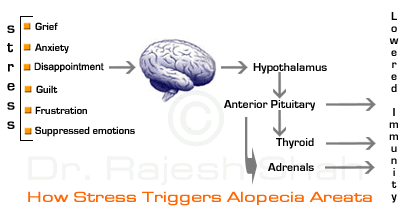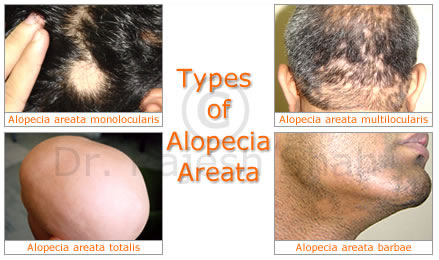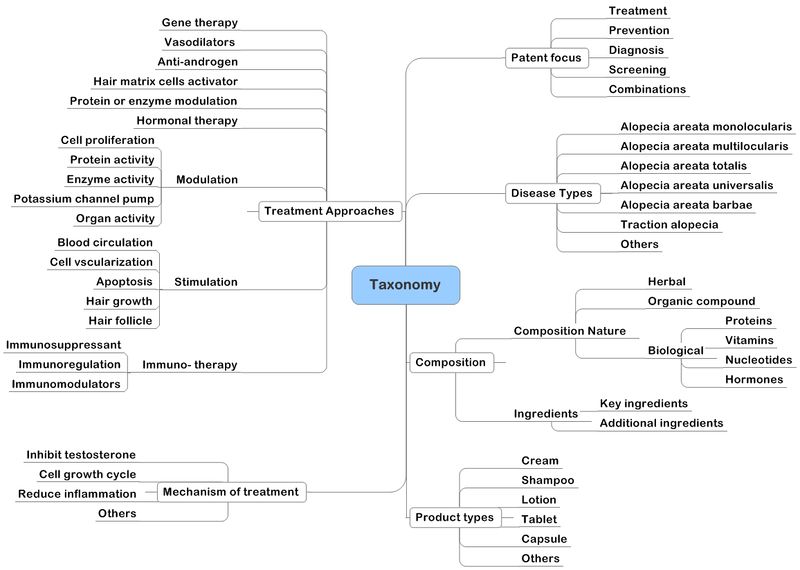Alopecia areata - Patent and Technology Mapping
Overview
Alopecia areata (‘baldness in spots') is a form of hair loss, usually from the scalp, although it can affect other areas of the body. The hair loss mostly remains limited to the scalp but in certain cases it can extend to eyebrows, eyelashes, facial hair (beard, moustache), nasal hair and give rise to bald spots anywhere in the body.
Alopecia can affect both men and women and it is not uncommon to see children affected with this disorder. Approximately 2% of the general population worldwide suffers from alopecia areata.
Understanding alopecia areata: The hair is made up of a protein called keratin which is also the main constituent of nails. A specialised structure inside the skin called ‘Papilla' produces the hair as shown in the figure. The papilla is surrounded by a sac-like structure called the ‘Hair follicle' which also surrounds rest of the hair root within the skin. The part of the hair outside the skin surface is called as shaft. Source
Alopecia areata is considered to be an auto-immune condition in which the immune system of the body (which protects the body from bacteria and viruses) mistakenly attacks the hair follicles and destroys them. This leads to hair loss in the affected area.
The commonest presentation of alopecia areata is appearance of bald patches on the scalp. In most cases, hair falls out in small, round patches about the size of a small coin. The patient may have single or multiple such patches. In some cases these patches may remain static, whereas in some cases the patches may spread to involve larger areas of the scalp. In some cases, hair loss is more extensive. Although it is not very common, the disease can progress to cause total loss of hair on the head (alopecia areata totalis) or complete loss of hair on the head, face, and rest of the body (alopecia areata universalis).
Causes
Alopecia areata is considered to be an auto-immune condition in which the immune system of the body (which protects the body from bacteria, viruses, allergens, etc.) mistakenly attacks the hair follicles and destroys them. This leads to hair loss in the affected area. This abnormal behavior of the immune system is understood to be guided, influenced and triggered by multiple factors.
The exact cause, why hair follicles undergo this kind of destruction, is not known but a genetic component to this is suspected. Family history of alopecia areata or any of the other auto-immune diseases (such as hypothyroid, diabetes, cancer, ulcerative colitis, rheumatoid arthritis, etc.) is often seen in many cases, suggesting a role of genetic element. In addition to the genetic predisposition, certain triggering factors may bring on the onset of this condition. Prolonged underlying stress often predisposes some patients to develop auto-immune process leading to alopecia areata. However, stress may not be the cause in every case.
Some other common causative factors that can contribute to the development of alopecia areata have been mentioned below:
One or more of the following factors may be found responsible in cases of alopecia areata:
- Hormonal cause: High levels of the male hormones (in men as well as in women) can trigger the onset of alopecia
- Thyroid disorders
- Drugs and medications:
- Commonest is this group are chemotherapy drugs, certain medicines used for gout, arthritis, depression, hypertension, ischemic heart disease, etc
- Large doses of Vitamin A can also trigger alopecia
- Oral contraceptive pills
- Chemical treatment of hair, exposure of hair to excessive heat
- Low levels of iron
- Poor protein intake
- Physical stress: After undergoing some major surgery, or due to some chronic illness, rapid weight loss due to dieting
- SLE (Systemic lupus erythematosus)
- Fungal infection of the scalp
Types of Alopecia areata
- Alopecia areata monolocularis : In this condition there is a single bald spot on the scalp.
- Alopecia areata multilocularis: In this condition there are multiple bald spot on the scalp.
- Alopecia areata totalis : In this condition, the patient loses all the hair on the scalp.
- Alopecia areata universalis : In this condition, all body hair, including pubic hair, is lost.
- Alopecia areata barbae : In this condition, the disease is limited only to the beard region.
- Traction alopecia : In this condition, alopecia develops along the frontal margins and temporal margins of the scalp due to constant tension on the hair from being tied very tightly.
Molecular Mechanism
Alopecia areata is an autoimmune disease in which cells of the anagen hair bulb are attacked by T lymphocytes. In a process resembling chemotherapy-induced hair loss, lymphocyte infiltration of the growing hair bulb forces the anagen follicles into dystrophic catagen, causing the hair shaft to break off. Possible targets of autoimmune attack in alopecia areata include matrix keratinocytes, dermal papilla cells, and melanocytes. Linkage analyses indicate that this disease has a genetic component, though the range of associated genes, including the major histocompatibility complex, cytokine and immunoglobulin genes.
Market Information
Epidemiological aspects
- The disease can begin at any time of life, but with a peak incidence between 20 and 50 years of age, and other articles affirm 60% of the patients present the first episode of the disease before 20 years of age.
- Alopecia areata accounts for 2% of the first dermatological consultations in the United Kingdom and United States.
- The prevalence of AA in the United States, between 1971 and 1974, varied from 0.1% to 0.2% of the population.9 Some works have estimated that about 1.7% of the population presents at least one episode of AA during their life. Source
Clinical and Drug trials
Clinical Trials
The format for each of the following is:
- The name of the trial,
- followed by whether the trial is recruiting patients,
- The trial may not have started and not yet recruiting, or the trial may have started and do not need any more recruitements, or the trial may be completed.
- Note**: Please follow the link to determine the current trial status.
- followed by a list of drug/s, if any, used in the trial
ClinicalTrials.gov has listed the following trials for Alopecia Areata:
- Alopecia Areata Registry - This study is currently recruiting patients (Current: 23 Nov 2006)
- Alefacept in Patients With Severe Scalp Alopecia Areata - This study is currently recruiting patients (Current: 23 Nov 2006) - Alefacept
- Efficacy Study of Latanoprost and Bimatoprost Solutions in Promoting Eyelash Growth in Patients With Alopecia Areata - This study is no longer recruiting patients (Current: 23 Nov 2006) - Latanoprost (Xalatan),Bimatoprost (Lumigan)
- Plaquenil for Alopecia Areata, Alopecia Totalis - This study is currently recruiting patients (Current: 23 Nov 2006) - Hydroxychloroquine
- Phase II Randomized Bilateral Comparison of Topical Targretin Gel 1% in Alopecia Areata - This study is currently recruiting patients (Current: 23 Nov 2006) - Targretin Gel 1%
- Characteristics of T Cells From Alopecia Areata Scalp Skin Before and After Treatment With Aldara 5% - This study has been completed (Current: 23 Nov 2006) - Aldara Cream 5%
- Response of Topical Capsaicin in Alopecia Areata - This study has been completed (Current: 23 Nov 2006) - Capsaicin
- Aldara for the Treatment of Extensive Alopecia Areata - This study has been completed (Current: 23 Nov 2006) - Aldara Cream 5%
- Alopecia Areata Registry and Immunogenetic Mechanisms - This study is currently recruiting patients (Current: 23 Nov 2006)
Drug Trials
The format for each of the following is:
- The drug,
- followed by the name of the trial,
- followed by whether the trial is recruiting patients,
- The trial may not have started and not yet recruiting, or the trial may have started and do not need any more recruitements, or the trial may be completed.
- Note**: Please follow the link to determine the current trial status.
ClinicalTrials.gov has listed the following drugs in trials for Alopecia Areata:
- Aldara Cream 5% - Aldara for the Treatment of Extensive Alopecia Areata - This study has been completed (Current: 23 Nov 2006)
- Aldara Cream 5% - Characteristics of T Cells From Alopecia Areata Scalp Skin Before and After Treatment With Aldara 5% - This study has been completed (Current: 23 Nov 2006)
- Alefacept - Alefacept in Patients With Severe Scalp Alopecia Areata - This study is currently recruiting patients (Current: 23 Nov 2006)
- Bimatoprost (Lumigan) - Efficacy Study of Latanoprost and Bimatoprost Solutions in Promoting Eyelash Growth in Patients With Alopecia Areata - This study is no longer recruiting patients (Current: 23 Nov 2006)
- Capsaicin - Response of Topical Capsaicin in Alopecia Areata - This study has been completed (Current: 23 Nov 2006)
- Hydroxychloroquine - Plaquenil for Alopecia Areata, Alopecia Totalis - This study is currently recruiting patients (Current: 23 Nov 2006)
- Latanoprost (Xalatan) - Efficacy Study of Latanoprost and Bimatoprost Solutions in Promoting Eyelash Growth in Patients With Alopecia Areata - This study is no longer recruiting patients (Current: 23 Nov 2006)
- Targretin Gel 1% - Phase II Randomized Bilateral Comparison of Topical Targretin Gel 1% in Alopecia Areata - This study is currently recruiting patients (Current: 23 Nov 2006)
Treatment Approaches
The following are some of the common treatments used for alopecia areata in conventional medical practice. These treatments may promote hair growth but none of them prevent new patches from appearing or actually cure the underlying disease; thus they are nothing more than temporary measures for treating alopecia areata:
- Corticosteroids: These drugs have strong anti-inflammatory action and they suppress the immune system if given orally so they are often used in the treatment of various autoimmune diseases, including alopecia areata. Corticosteroids may be administered in three ways for alopecia areata:
- As local injections in the affected area
- As oral medication
- As topical ointments
- Minoxidil: Topical application of minoxidil solution is one of the commonest prescriptions for alopecia areata. Minoxidil is said to promote hair growth in several conditions in which the hair follicle is small and not growing to its full potential.
- Anthralin: Anthralin, a synthetic tar-like substance that is commonly used to treat alopecia areata. It is often used in combination with other treatments, such as corticosteroid injections or minoxidil.
- Oral cyclosporine: An immuno-suppressor drug, Cyclosporine is used in some cases of alopecia areata though it must be kept in mind that its side-effects include risk of serious infection and possibly skin cancer. It must be noted that the dangers of this drug outweigh its benefits for alopecia areata.
- Sulfasalazine: Sulfasalazine acts on the immune system and it is used in severe cases of alopecia areata.
- PUVA treatment: In PUVA (also called photochemotherapy), a drug called a psoralen is applied topically or taken orally and then the alopecia patch is exposed to an ultraviolet light source.
- Alternative therapies: Alternative therapies commonly used by patients for alopecia areata include acupuncture, aroma therapy, evening primrose oil, zinc and vitamin supplements, and Chinese herbs. Source
Intellectual Property
Patent Search Strategy
Search scope: US Granted US Applications EP-A EP-B WO JP (bibliographic data only) DE-C,B DE-A DE-T DE-U GB-A FR-A
Limitation: Claims, Title or Abstract
Years: 1836-2007
Text: (((alopecia ADJ areata) OR (baldness ADJ spots))) AND (Minimiz* OR Promote OR inhibit* OR reduce* OR stimulat* OR treatment OR prevention) AND (hair))
Hits: 100 Unique patent families
Date of Search: 5th April 2007
Taxonomy
Key Competitors
- Merck is the key players with 19 patents, followed by Abbott with 2 patents.



